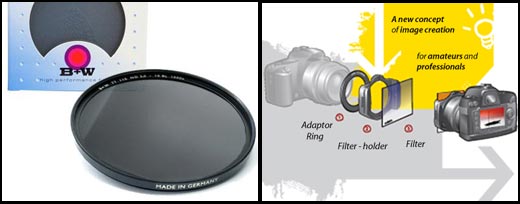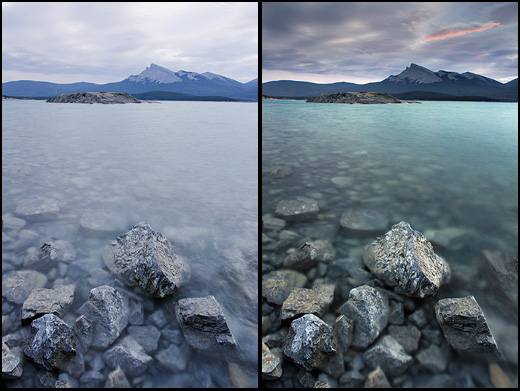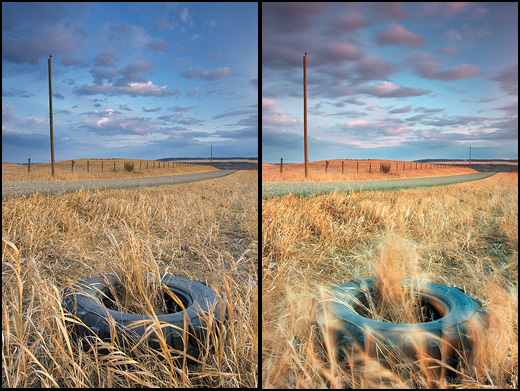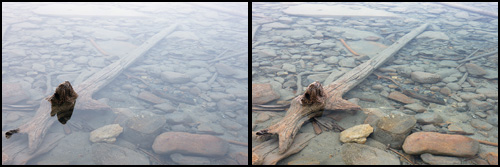Photography podcast #77 features an interview with Darwin Wiggett where we talk about neutral density filters and graduated neutral density filters. Darwin explains why we use these filters and how to use these filters effectively. We discuss hard edge versus soft edge, physical versus software filters, we even talk about reverse graduated neutral density filters. For newbie photographers that have just hatched, Darwin goes over polarizing filters as well.

Left — Screw on neutral density filter. Right — The Cokin system
![]()

Left — Lake with no filter. Right — Lake with polarizer and-2-stop hard edge grad. Notice how much ‘poppier’ this shot is. The grad reduces the sky’s intensity. The polarizer adds contrast to the clouds in the sky and intensifies its colour. It also removes the water’s reflections thus saturating its colours. ‚© Darwin Wiggett
![]()

Left — Tire with Polarizer and-2-stop-hard-grad. Right — Tire with a Polarizing filter plus a 2-stop-hard-edge grad and-a 5-stop solid-ND filter. Note the movement of the foreground brush and the softness in the clouds. This was achieved by using the solid ND filter to get a slow shutter speed. ‚© Darwin Wiggett.
![]()

The effect of a polarizer on its own. Left — No polarizing filter. Right — The polarizing filter lets you see through the water by eliminating the water’s reflectivity. With the reflections removed, the colour is much more saturated. ‚© Darwin Wiggett
Links /resources mentioned in this podcast:
Seven Rules for Effectively Using a Polarizer
Filters, holders and vignetting: building a filter system that works with your lenses
The Terrific Triple Threat
Fields of Gold (or was that blue?) Three Camera Filters all Digital Photographers Should be Using
Filters for Outdoor Photography
January’s macro or close-up assignment on the Photography.ca forum
Cokin filters at B&H (Disclosure — Aff links — help support our site)
Singh-Ray filters at B&H
Lee filters at B&H
Please join the Photography.ca fan page on Facebook
My Facebook profile — Feel free to “friend” me — please just mention Photography.ca
My Twitter page — I will follow you if you follow me — Let’s connect — PLEASE email me and tell me who you are in case I don’t reciprocate because I think you are a spammer.
If you are still lurking on our forum,
feel free to join our friendly ![]() Photography forum
Photography forum
Thanks to jacklabel, AcadieLibre and Mars observer who posted a blog comment about our last podcast. Thanks as always to everyone that sent comments by email about our last podcast. Although ALL comments are appreciated, commenting directly in this blog is preferred. Thanks as well to all the new members of the bulletin board.
If you are looking at this material on any other site except Photography.ca — Please hop on over to the Photography.ca blog and podcast and get this and other photography info directly from the source. I Subscribe with iTunes I Subscribe via RSS feed I Subscribe with Google Reader I Subscribe for free to the Photography podcast — Photography.ca and get all the posts/podcasts by Email
You can download this photography podcast directly by clicking the preceding link or listen to it almost immediately with the embedded player below.
Podcast: Play in new window | Download



No worries mate — we all have to learn sometime
Glad you are using it NOW at least. I use mine 99% of the time on 100% of my lenses when I’m shooting outdoors during the day, regardless of subject matter. Thx for the comment!
This was an excellent podcast. Thank you very much. I started using the polarizing filter all the time as you are doing. You are right, when I use my sunglasses with polarizer lens everything looks much better. So there is no reason why I should not use the polarizing filter in with my camera. It was a shame on me not using them more ofter before. My camera is a Canon 5D Mark II with plenty of ISO room. The lenses that I use the more are 70–200 is f2.8 and 50mm f1.4 which are really fast. I have no excuses for not using the polarizing filters all the time.
Hi Marko,
great podcasts. I enjoy them very much. And this one about the nd filters came just right cause I was thinking to buy one. Manly for video shooting with my 7D but now I know to use the hole advantage also for photography.
I also found an interesting link from fxguide.tv. It’s episode #74 and they are talking also of ND filters and compare different brands. Enjoy.
http://www.fxguide.com/fxguidetv.html
Greetings from germany,
Bjoern
Very interesting and clear podcast! I’ll be pointing people to this one for sure!
One comment though: You’ve talked about the vignetting that occures with the Cokin P system. The regular P holder produces vignetting at 18mm or lower on a crop camera. However, Cokin also has a wide angle holder for the P system. This plastic holder will only hold one filter at a time (instead of 3), but is usable for wide angle lenses all the way up to 10mm (on a crop camera).
http://www.cokin.com/ico15/ico15-haut.html?=#p
Thought I’d meantion it. I’m not a Cokin salesperson by the way…
Tnx!
Very interesting and informative podcast. I think I will make a lot more use of my polarising filter which until now I have hardly used.
Thanks.
Marko and Darwin
thanks so much for this post. It made so much sense to someone like me who is very new to SLR. Definitely will get one of these to add to my kit!
That’s a great idea F8! I’ll try to do this next interview!
Excellent podcast Marko! Great guest, very concise info, very interesting, fantastic tips– I didn’t want it to end. Do you think you might in the future interview a guest and have a brief questions from the subscribers kind of segment (by email or forum post of course, not live call in)?
Thanks for that Zenon — but what does “Also the tips on J0K 3E0” that mean?
Thanks for that tip Jack — makes perfect sense to me.
Great post Marko, ND filters are very useful for many things, i have seen an architectural photographer using it to remove people from the scene, since the day was soso, and there were some people walking by the building, he used ND filters to make such a long exposure that all moving people simple didnt record in the final image.
This is the MOST interesting (for me ) podcast you ever did. Thanks a whole lot for the very useful information. Also the tips on J0K 3E0
Thanks muchly for the comments Jas and MVT!
Darwin & Marko,
One thing is for certain there is no substitute for a ND filter to help you get those shallow DOF shots on a bright sunny day.
Great podcast Marko!
Regards,
MikeV
Great stuff, Marko. It really helps to sort out all my questions. Prior to this podcast, and after driving the salesperson crazy with questions, I bought a Singh Ray LB warming polarizer. One step in the right direction. Thanks too, for all the links to Darwins websites. Ha! Ha! Now the next thing I am going to drive you crazy with is about exposing to the right.